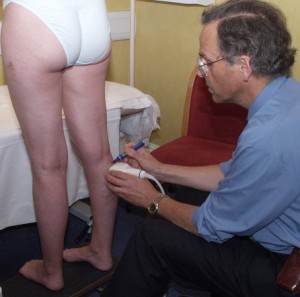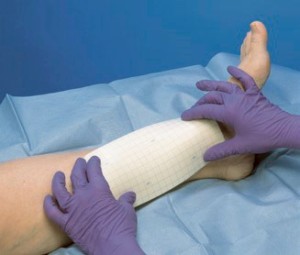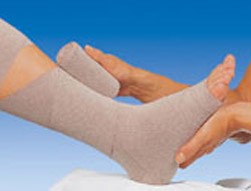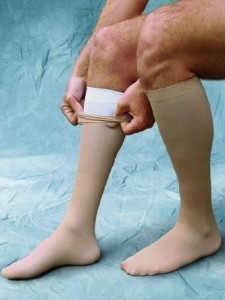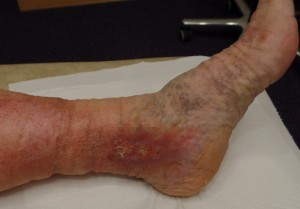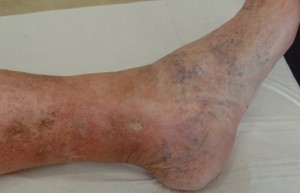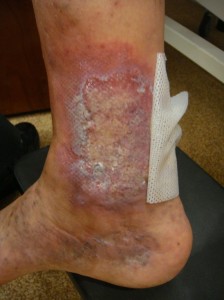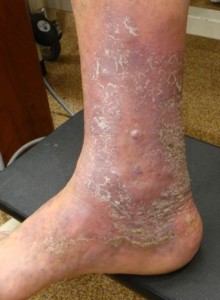Leg Ulcers
Causes of leg ulcers
A leg ulcer is a chronic non-healing wound of the leg which may be painful and unpleasent to live with. Frequent dressing changes are required to care for the ulcer.
The most common problems giving rise to leg ulcers are:
- Venous disease of the leg
- Arterial disease of the leg
Other common causes include:
- Diabetes
- Rheumatoid disease
- Vasculitis – inflammation of small blood vessels
- Injuries to the leg
- Infections of the leg
- Tumours of the leg
There is a further, much longer list of rare and very rare conditions which also cause leg ulceration.
Management of leg ulcers
The most important thing is to find out what is causing the leg ulcer. Problems with veins and arteries account for about 90% of leg ulcers. These are conditions which are treatable by a range of modern techniques. Treatment of troublesome arteries and veins lead to healing of the ulcers
The starting point to assess the arteries and veins in the leg. This is easily done in the clinic using colour duplex ultrasound imaging.
Varicose veins are the most common cause of leg ulcers and are a factor in causing ulcer in about 70% of cases. Sometimes, the deep veins have been affected by a previous deep vein thrombosis and damaged valves in these veins cause leg ulcers. Arterial disease in the leg is a factor in causing leg ulcers in 20 – 30% of cases. Blocked arteries reduce the blood flow to the leg and may cause an ulcer or prevent an ulcer from healing.
Varicose veins and blocked arteries are both treatable using a range of modern techniques. Varicose veins treatments are available in our clinic. Blocked arteries are treated using dilation with balloon catheters combined with stenting. This often done by an interventinoal radiologist.
Where the problem is not caused by faulty arteries or veins, detailed blood tests and a biopsy of the ulcer may be helpful in finding out what the problem is. The treatment of other types of ulcers depends very much on the cause of the problem.
Treatment of venous leg ulcers
When ultrasound imaging shows that there is a venous cause for the leg ulcer, either varicose veins or deep vein problems, and the arteries are working well, the first step is to apply a compression bandage or stocking to the leg. The use of compression bandages or stockings has been shown to promote the healing of leg ulcers.
Cleaning of leg ulcers
Frequent cleaning and redressing of leg ulcers is required to ensure that a healing environment is maintained for the ulcer. This may have to be done daily or once every several days depending on how much exudate arises from the ulcer. Cleaning the ulcer with tap water from a shower head is very effective. Sterile solutions are not required since all leg ulcers contain many bacteria. Despite this infections are uncommon. The bacteria are not the cause of the ulcer and will not go away until the ulcer heals. Treatment with antibiotics is useless for venous leg ulcers and does not promote healing.
Many types of ulcer dressing are avaialble. An example is shown here.
The next stage is to apply a compression bandage or stocking. Bandages are useful for large ulcers but usually need to be applied by a nurse. Our preferred bandage type is ‘PehaHaft (Hartmann)’.
Medical compression stockings are often used where patients care for their own ulcers. They can be difficult to apply but several devices are available to help get the stockings over the dressing and onto the leg.
In cases where varicose veins are the cause of a leg ulcer, treatment of the varicose veins by one of the minimally invasive technqiues we can perform in the clinic. We usually combine the use of a compression bandage or stocking with treatment of the varicose veins in order to ensure rapid healing of the leg ulcer.
Here are two patients treated in the clinic. Both arrived with troublesome ulcers which had been present for several months. Ultrasound imaging showed that both patients had varicose veins that could not be easily seen without the help of an ultrasound imaging machine. The varicose veins were treated with laser ablation and ultrasound guided foam sclerotherapy. Both ulcers healed within a few weeks.
First patient
Second patient
Many venous ulcers can be healed using this strategy. We don’t wait for compression bandaging or stockings to heal the ulcer before treating the varicose veins. This leads to most ulcers healing within 3 months of starting treatment. Following this, many patients can stop wearing stockings or bandages. In the longer term, most venous ulcers remain healed, although we always ask our patients to return at any sign of a deterioration in the leg.




